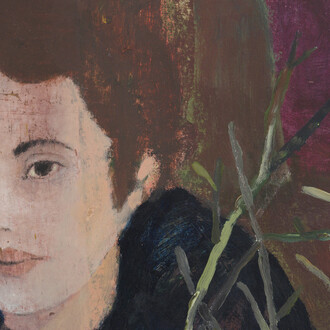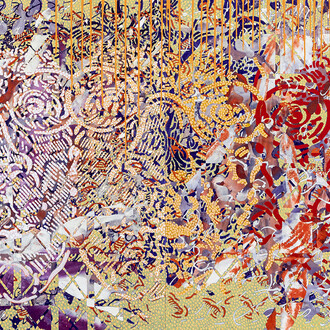Conversation between Alberta Pane and João Vilhena.
AP : I’m very pleased with your next exhibition at the gallery. The last time we spoke, you told me your idea for the title – it’s mysterious and intriguing at the same time, can you tell me more about it?
JV : "Érothéisme, le dessin sacré", I came up with this title after reading the works of Georges Bataille. I have been following, for some years now, an approach to drawing focused on eroticism. I immediately responded to the relationship that Bataille proposes between the erotic and the holy. In this idea that the two, in the end, are intrinsically connected, I recognized a great part of my work. So I decided to dig deeper into the matter…
It’s true that an erotic touch is always present in your work… But, as you told me more than once, it has nothing to do with pornography. Now, it is strong to associate it with the holy… Ambitious as well…
I agree. But I believe that art has always been connected to the holy, at least until the modern era. The holy and the erotic have always been paired. When you think about the frescos of the Sistine Chapel, you can’t help but wonder whether the development of the sacred meaning of the images is not erotic after all. What I find interesting about eroticism is its power of transgression, which can lift a taboo without completely suppressing it. Nowadays art has probably nothing to do with the divine, but I do believe that it still retains something holy in its transgressive function.
It can be difficult to draw a line between eroticism and pornography. It is a matter of culture, but it seems to me that modern pornography takes all sacrality out of the representation by its obscenity: it’s either shocking or exciting (or both)… at an artistic level, I wouldn’t know what to do with it.
Yes, in fact there has always been a connection between the holy and the erotic… But let’s talk about your works for the upcoming exhibition… Generally, for your smaller drawings you always use the same kind of paper in the same size, why? Will it be the same for the next exhibition? As for the bigger size, you prefer cardboard… Can you tell me more about that? And how you decide whether to make a drawing in a smaller or bigger format? Are you going to make some changes?
I have been carrying on this series of small trompe-l'oeil drawings for the past 16 years. When I first started it, I was looking for a smooth paper, which I thought would work best for a very detailed drawing. So I bought a ream of A3 photocopy paper and so far I have used half of it – since this kind of paper is no longer produced, the series will come to an end the day I finish these sheets. Using this small size allowed me to start working on sight and perception, which has been a current aspect of my work ever since. What I love about this format, is that being so small it forces people to get closer to the work and stare at it. I think that this will never change…
As for the bigger-sized works, they originated from the trompe-l'oeil series. They are however a different way of saying things about sight. This series allows me to focus on the idea of reproduction by approaching the documents that I represent in a very photorealistic way. This idea of reproduction is highlighted by the slight anamorphoses that I use on each image – as if the obliquity of the presentation was an evidence of it being split in two. I chose grey cardboard for two reasons: first, I didn’t want to work on a spotless white medium. I wanted to approach drawing in a similar way as during the Renaissance, when drawings were executed on colored or grey paper. Then, I wanted a medium that had nothing noble about it. In fact, grey cardboard, which is like felt made out of paper, is basically produced with recycled materials. This recycling mirrors that of the images of old postcards or stereoscopic views that I use in my drawings.
I draw directly both in the small and in the big format. However, it happens to use compositions of images that are very similar from the point of view of the subject, both in the big and small format. It’s not systematic – sometimes I feel like approaching the same subject differently. But there are certain works, like “Fouille courageuse” that I can’t even imagine in a small format. Same thing for small formats: I can’t always imagine them bigger.
What are your future projects?
For a few months now, I have been researching about the extinction of certain species, which have been decimated by man during the last two centuries. Disappearance is a theme that I had already approached a long time ago in my drawings. I think of my works as a journey, a wandering. Sometimes I pass where I already had the chance to pass.
What do you expect from your upcoming exhibition in Paris?
That’s a question I have an hard time answering to… Perhaps I expect that the works that I am creating especially for this exhibition, once they are all installed together, will open new questions and new perspectives for me. That’s what the static journey of the atelier is about.
















